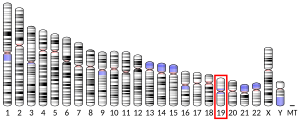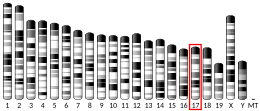RFX2
DNA-binding protein RFX2 is a protein that in humans is encoded by the RFX2 gene.[5][6]
This gene is a member of the regulatory factor X gene family, which encodes transcription factors that contain a highly-conserved winged helix DNA binding domain. The protein encoded by this gene is structurally related to regulatory factors X1, X3, X4, and X5. It is a transcriptional activator that can bind DNA as a monomer or as a heterodimer with other RFX family members. This protein can bind to cis elements in the promoter of the IL-5 receptor alpha gene. Two transcript variants encoding different isoforms have been described for this gene, and both variants utilize alternative polyadenylation sites.[6]
References
[edit]- ^ a b c GRCh38: Ensembl release 89: ENSG00000087903 – Ensembl, May 2017
- ^ a b c GRCm38: Ensembl release 89: ENSMUSG00000024206 – Ensembl, May 2017
- ^ "Human PubMed Reference:". National Center for Biotechnology Information, U.S. National Library of Medicine.
- ^ "Mouse PubMed Reference:". National Center for Biotechnology Information, U.S. National Library of Medicine.
- ^ Pugliatti L, Derre J, Berger R, Ucla C, Reith W, Mach B (Sep 1992). "The genes for MHC class II regulatory factors RFX1 and RFX2 are located on the short arm of chromosome 19". Genomics. 13 (4): 1307–10. doi:10.1016/0888-7543(92)90052-T. PMID 1505960.
- ^ a b "Entrez Gene: RFX2 regulatory factor X, 2 (influences HLA class II expression)".
Further reading
[edit]- Reith W, Ucla C, Barras E, et al. (1994). "RFX1, a transactivator of hepatitis B virus enhancer I, belongs to a novel family of homodimeric and heterodimeric DNA-binding proteins". Mol. Cell. Biol. 14 (2): 1230–44. doi:10.1128/MCB.14.2.1230. PMC 358479. PMID 8289803.
- Doyle J, Hoffman S, Ucla C, et al. (1996). "Locations of human and mouse genes encoding the RFX1 and RFX2 transcription factor proteins". Genomics. 35 (1): 227–30. doi:10.1006/geno.1996.0343. PMID 8661125.
- Hillier LD, Lennon G, Becker M, et al. (1997). "Generation and analysis of 280,000 human expressed sequence tags". Genome Res. 6 (9): 807–28. doi:10.1101/gr.6.9.807. PMID 8889549.
- Iwama A, Pan J, Zhang P, et al. (1999). "Dimeric RFX proteins contribute to the activity and lineage specificity of the interleukin-5 receptor alpha promoter through activation and repression domains". Mol. Cell. Biol. 19 (6): 3940–50. doi:10.1128/MCB.19.6.3940. PMC 104353. PMID 10330134.
- Morotomi-Yano K, Yano K, Saito H, et al. (2002). "Human regulatory factor X 4 (RFX4) is a testis-specific dimeric DNA-binding protein that cooperates with other human RFX members". J. Biol. Chem. 277 (1): 836–42. doi:10.1074/jbc.M108638200. PMID 11682486.
- Sengupta PK, Fargo J, Smith BD (2002). "The RFX family interacts at the collagen (COL1A2) start site and represses transcription". J. Biol. Chem. 277 (28): 24926–37. doi:10.1074/jbc.M111712200. PMID 11986307.
- Strausberg RL, Feingold EA, Grouse LH, et al. (2003). "Generation and initial analysis of more than 15,000 full-length human and mouse cDNA sequences". Proc. Natl. Acad. Sci. U.S.A. 99 (26): 16899–903. Bibcode:2002PNAS...9916899M. doi:10.1073/pnas.242603899. PMC 139241. PMID 12477932.
- Ota T, Suzuki Y, Nishikawa T, et al. (2004). "Complete sequencing and characterization of 21,243 full-length human cDNAs". Nat. Genet. 36 (1): 40–5. doi:10.1038/ng1285. PMID 14702039.
- Maijgren S, Sur I, Nilsson M, Toftgård R (2004). "Involvement of RFX proteins in transcriptional activation from a Ras-responsive enhancer element". Arch. Dermatol. Res. 295 (11): 482–9. doi:10.1007/s00403-004-0456-5. PMID 15024578. S2CID 2408607.
- Horvath GC, Kistler WS, Kistler MK (2005). "RFX2 is a potential transcriptional regulatory factor for histone H1t and other genes expressed during the meiotic phase of spermatogenesis". Biol. Reprod. 71 (5): 1551–9. doi:10.1095/biolreprod.104.032268. PMID 15229132.
- Rual JF, Venkatesan K, Hao T, et al. (2005). "Towards a proteome-scale map of the human protein-protein interaction network". Nature. 437 (7062): 1173–8. Bibcode:2005Natur.437.1173R. doi:10.1038/nature04209. PMID 16189514. S2CID 4427026.
External links
[edit]- RFX2+protein,+human at the U.S. National Library of Medicine Medical Subject Headings (MeSH)
This article incorporates text from the United States National Library of Medicine, which is in the public domain.




